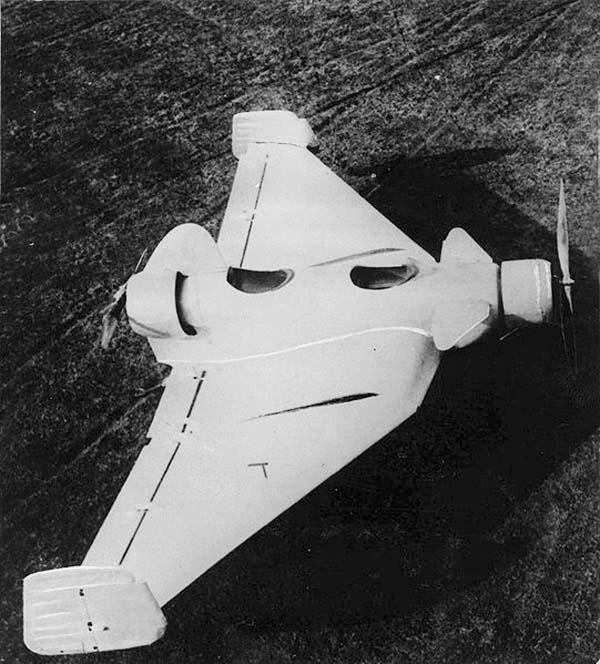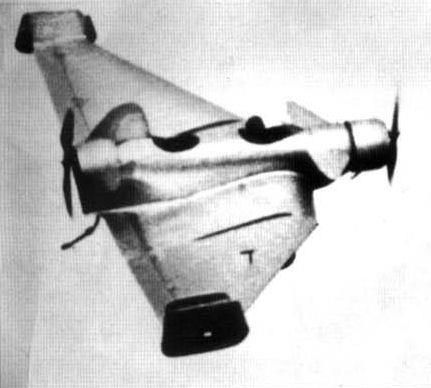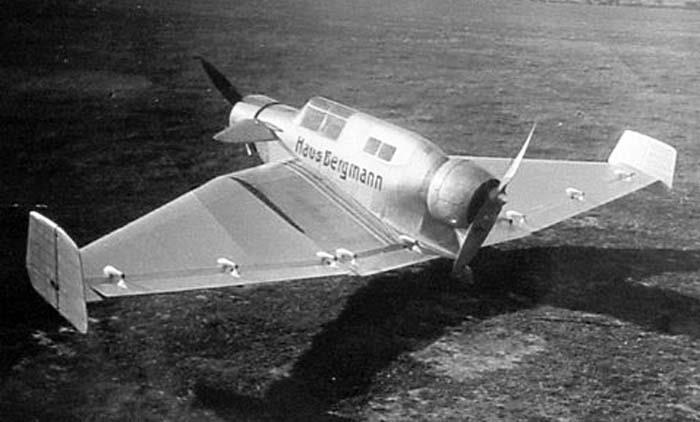Die Fieseler F 3 „Wespe“ war ein zweisitziges schwanzloses Motorflugzeug in Deltaform mit zwei in Tandemanordnung angeordneten Motoren. Die Konstruktion erfolgte durch Alexander Lippisch von der Rhön-Rossitten-Gesellschaft (RRG); den Bau von drei Maschinen führte der Fieseler Flugzeugbau aus. Testflüge ergaben, dass dieses Flugzeug fliegerisch nicht beherrschbar war, daher wurde das Projekt eingestellt.
Inhaltsverzeichnis
[Verbergen] 1 Geschichte
2 Konstruktion
3 Flugeigenschaften
4 Verbleib
5 Technische Daten
6 Siehe auch
7 Literatur
Geschichte[Bearbeiten]
Die Zigarettenfirma Haus Bergmann in Dresden plante, für den Europarundflug 1932 drei doppelsitzige Motorflugzeuge einzusetzen, die durch Aussehen und Leistung besonders auffällig sein sollten. Man wollte diese als wirkungsvolle Werbeträger nutzen und fragte bei dem Fieseler Flugzeugbau in Kassel an. Gerhard Fieselers Idee war es, ein Sport- und Reiseflugzeug in einer für die damalige Zeit außergewöhnlichen Delta-Formgebung zu entwickeln, das als besonderes Sicherheitsmerkmal zwei Motoren in Tandemanordnung erhalten sollte. Deshalb setzte er sich mit der RRG auf der Wasserkuppe in Verbindung. Dort hatte der Chefkonstrukteur Alexander Lippisch bereits erfolgreich Segel- und Motorflugzeuge als Nurflügel entwickelt. Die RRG erklärte sich bereit, ein derartiges Flugzeug zu konstruieren und es bis zur Abnahme durch die Deutsche Versuchsanstalt für Luftfahrt (DVL) zu bringen. Zum Arbeitsumfang des Fieseler Flugzeugbau gehörte die Herstellung und das Einfliegen der Maschine. Die Zigarettenfirma war mit Fieselers Vorschlag einverstanden und erteilte ihm den Auftrag über drei dieser Flugzeuge.
Konstruktion[Bearbeiten]
Pobjoy R: wegen des Untersetzungsgetriebes ist die Motorwelle nicht mittig angeordnet
Bei der RRG wurde im Winter 1931/32 mit der Entwicklung dieses Flugzeugtyps unter der Bezeichnung „Delta IV“ begonnen; im Fieseler Flugzeugbau erhielt es den Namen F 3 „Wespe“. Es entstand eine Maschine, deren Tragwerk trapezförmig ausfiel. Die Quer- und Höhenruder bildeten in einer Linie die Hinterkante der Tragflächen. Zwei Seitenruder wurden als Endscheiben an den Flächenspitzen angeordnet. Entsprechend der Wettbewerbsausschreibung mussten die Flügel zudem zusammenklappbar sein.
Im Rumpf waren die beiden Motoren jeweils am Bug und am Heck angebracht, je ein Propeller lief im Zug- bzw. Druckbetrieb. Bei der Wahl der Motoren fiel die Entscheidung auf den britischen 7-Zylinder-Sternmotor „Pobjoy R“. Die beiden Sitze befanden sich hintereinander angeordnet zwischen den Antrieben. Das Fahrwerk bestand aus zwei Rädern vorn und einem beweglichen Sporn hinten. Da Fieseler von der Kompetenz der RRG für diesen Auftrag überzeugt war, legte er sofort eine Serie von drei Stück auf. Aufgrund der guten Zusammenarbeit von Konstrukteuren und Flugzeugbauern stand die erste Maschine im Mai 1932 zum Erstflug auf dem Flugplatz Kassel-Waldau bereit.
Flugeigenschaften[Bearbeiten]
Gerhard Fieseler war zu der Zeit auch der Testpilot seines Unternehmens. Nach Rollversuchen kam es bereits beim ersten Abheben des Flugzeuges durch eine unkontrollierbare Flugbewegung um die Querachse zum Bruch der Maschine. Die Arbeiten an den zwei weiteren Maschinen ließ Fieseler stoppen. Nach der Reparatur und konstruktiven Änderungen durch die RRG versuchte Fieseler, die F 3 in die Luft zu bekommen. Selbst zwei weitere Brüche am Boden hielten ihn nicht von diesem Vorhaben ab. Inzwischen waren vor dem Hauptflügel ein zusätzliches Höhenruder angebaut und die Fahrwerksanordnung sowie die Leitwerke geändert worden. Nun gelangen Fieseler unter Aufbietung seines ganzen fliegerischen Könnens die ersten Platzrunden. Er kam dabei zu der Überzeugung, dass sich die Flugeigenschaften nicht weiter verbessern ließen. Aus seiner Sicht war dieses Flugzeug für einen „Normalpiloten“ nicht zu beherrschen. Um von neutraler Stelle eine Aussage zu bekommen, bat er die DVL um das Nachfliegen der Maschine. Bevor dieses geschah, ließ Fieseler noch ein Doppelsteuer einbauen. Er einigte sich mit dem DVL-Piloten, dass er die F 3 starten und in eine sichere Flughöhe bringen sollte, um danach das Ruder zu übergeben. Der DLV-Pilot testete die Maschine und lehnte danach die Ausstellung einer Lufttüchtigkeitserklärung ab. Daraufhin beendete Fieseler das Projekt.
Verbleib[Bearbeiten]
Mit der Zigarettenfirma als Auftraggeber einigte man sich großzügig. Zwischen der RRG und Fieseler kam es zu einem Rechtsstreit mit anschließendem Vergleich. Dieser sah vor, dass die Probemaschine zu einem mäßigen Preis an die RRG ging und Fieseler für die zwei anderen Maschinen die Kosten aller Änderung und Reparaturen zu tragen hatte. Bei der RRG wurde die übernommene Delta IV komplett umkonstruiert; daraus entstand die DFS 39, ein doppelsitziges einmotoriges Sportflugzeug.
Technische Daten[Bearbeiten]
The cigarette company Haus Bergmann in Dresden planned to use for the European round flight 1932 three two seaters which should be particularly remarkable by appearance and achievement. They wanted to use these as effective advertising media and asked the Fieseler Flugzeugbau in Kassel to build these. Gerhard Fieselers's idea was to develop a sport and passenger aircraft using an unusual delta shape which should receive two engines in tandem arrangement . Thereforehe contacted the RRG on the Wasserkuppet.
There the head designer Alexander Lippisch already had successfully developed sail and power planes as flying wings. The RRG explained itself ready to design a such airplane and to bring it up to the decrease by the German laboratory for aviation (DVL). To the extent of work of the Fieseler aircraft construction the production and flying the machine belonged. The cigarette company agreed with Fieselers proposal and gave it the order over three of these airplanes. Pobjoy R: because of the reduction gear the motor shaft is not centrically arranged with the RRG in the winter of 1931/32 with the development this type of aircraft under the designation „delta IV "was begun; in the Fieseler aircraft construction received it to the names F 3 „wasp *. Developed a machine, whose wing unit failed trapezoidally.
The crosswise and elevators formed the rear edge of the bearing areas in a line. Two rudders were arranged as end plates at the surface points. According to the competition announcement the winqs had to be besides more collapsible. In the trunk the two engines were at the nose and attached at the tail, one propeller each ran in each case in the course and/or print plants- With the choice of the engines the decision fell on the British 7-cylinder radial engine „Pobjoy R *. The two seats were one behind the other arranged between the drives. The chassis consisted of two wheels in front and a mobile spur in the back. Since Fieseler was convinced of the competence of the RRG for this order, he presented immediately a series of three pieces. Due to the good co-operation of technical designers and aircraft manufacturers the first machine was available in May 1932 for the first flight on the airfield Kassel Waldau.
Gerhard Fieseler was at the time also a test pilot of its enterprise. To taxi tests it already came with first taking the airplane off by an uncontrollable aircraft movement around the transverse axis to the break of the machine. Fieseler let the work on the two further machines stop. After the repair and constructional changes by the RRG tried Fieseler to get the F 3 into air. Even two further breaks at the ground did not hold it from this project. In the meantime before the main wing an additional elevator and the chassis arrangement had been changed as well as the tail units had been cultivated. Now Fieseler arrive under mobilization of its whole aeronautical Konnens the first airfield traffic circuits. He came with the fact to the conviction that the flight
characteristics let themselves improve not further. From its view this airplane for one was not to be controlled „normal pilots*. In order to get from neutral place a statement, he asked the DVL for the Nachfliegen of the machine. Before this happened, Fieseler let a double tax still insert. He agreed to hand with the DVL pilot that he the F 3 start and into a safe flight altitude bring should, in order thereafter the rudder over. The DLV pilot tested the machine and rejected thereafter the exhibition of an airworthiness explanation.
at
project
With the cigarette company as clients one agreed generously. Between the RRG and Fieseler came to a law case with following result. The machine went to the RRG for a löw cost . RRG redesigned the machine and developed. the DFS 39, a two seat single-engine sport airplane
The cigarette company Haus Bergmann in Dresden planned to use three two seaters for the European round flight 1932 the aircraft to be particularly remarkable by appearance and achievement. They wanted to use these as effective advertising media and asked the Fieseler Flugzeugbau in Kassel to build these. Gerhard Fieselers's idea was to develop a sport and passenger aircraft using an unusual delta shape which should receive two engines in tandem arrangement . Therefore he contacted the RRG on the Wasserkuppet. Lippisch received an order from the Fieseler Aircraft Company in Kassel, for a sport monoplane with folding wings.. The resultant airplane, the Delta IV - Fieseler F3 "Wespe", was quickly designed and did not fulfill the requirements. Fieseler terminated the test flights in the fall of 1932. The elevators in front of the wing were retarding stalling in the midsection of the wing, allowing the outer sections of the wing to stall at smaller angles of attack, and this led to dangerous instability. The center of pressure also shifted, making the airplane tail-heavy. Near the conditions of maximum lift, the controls were not sufficiently responsive to compensate for this shift, and at the end of the test flights the airplane was seriously damaged during landing. With the cigarette company a generous agreement was reached . Between the RRG and Fieseler came to a legal case with the following result. The machine went to the RRG for a löw cost . RRG redesigned the machine and developed. the DFS 39, a two seat single-engine sport airplane
| Type |
Two seat sportplane |
| Engine |
2 Pobjoy R |
| Dimensions |
Length 4,54 m, height 1,75 m, wingspan 8,70 m, wing area 16,40 m2 |
| Weights |
Empty , loaded 680 kg, max. take off weight |
| Performance |
Max.. speed 250 km/h , cruising speed 215 km/h , range , endurance , service ceiling , climb |
| Type |
Werk.Nr |
Registration |
History |
|
|
|
"Haus Bergmann" |



